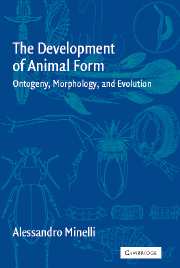Book contents
- Frontmatter
- Contents
- Preface
- Acknowledgements
- 1 The Nature of Development
- 2 Everything Begun to the Service of Development: Cellular Darwinism and the Origin of Animal Form
- 3 Development: Generic to Genetic
- 4 Periodisation
- 5 Body Regions: Their Boundaries and Complexity
- 6 Differentiation and Patterning
- 7 Size Factors
- 8 Axes and Symmetries
- 9 Segments
- 10 Evo-devo Perspectives on Homology
- Summary and Conclusions
- References
- Index
Preface
Published online by Cambridge University Press: 10 August 2009
- Frontmatter
- Contents
- Preface
- Acknowledgements
- 1 The Nature of Development
- 2 Everything Begun to the Service of Development: Cellular Darwinism and the Origin of Animal Form
- 3 Development: Generic to Genetic
- 4 Periodisation
- 5 Body Regions: Their Boundaries and Complexity
- 6 Differentiation and Patterning
- 7 Size Factors
- 8 Axes and Symmetries
- 9 Segments
- 10 Evo-devo Perspectives on Homology
- Summary and Conclusions
- References
- Index
Summary
Contemporary studies into the development and evolution of the head largely comprise two parallel approaches or research strategies: the model systems approach and the comparative approach. The two strategies share the same general goal – greater understanding of cranial development and evolution – but typically emphasize different problems, ask different questions, and employ different methods, reflecting the contrasting backgrounds and biases of each group of investigators; there has been relatively little true synthesis. Each strategy is making important and valid contributions, but both have limitations. Resolution of many fundamental and long-standing problems in cranial development and evolution will require a combined approach that incorporates the technical and conceptual strengths of each discipline.
J. Hanken 1993: 448Until recently, evolutionary biology and developmental biology have proceeded along separate pathways. Evolutionary biology is mainly a science of remote causes, investigating genotypic and phenotypic changes in species and populations, the origin of adaptations, and the diversity of life. Developmental biology, instead, is a science of proximate causes, grounded on experimental investigation of the cellular and biochemical mechanisms responsible for organ and tissue differentiation. The evolutionary biologist's interest in developmental biology was mainly limited to a little amount of descriptive embryology used to reconstruct phylogeny, but this loan has been steadily decreasing, along with growing dissatisfaction with Haeckel's recapitulationist views. Nevertheless, if the number of facts and concepts transferred from developmental biology to evolutionary biology was limited, the contribution of evolutionary biology to developmental biology was zero.
- Type
- Chapter
- Information
- The Development of Animal FormOntogeny, Morphology, and Evolution, pp. xiii - xviPublisher: Cambridge University PressPrint publication year: 2003



